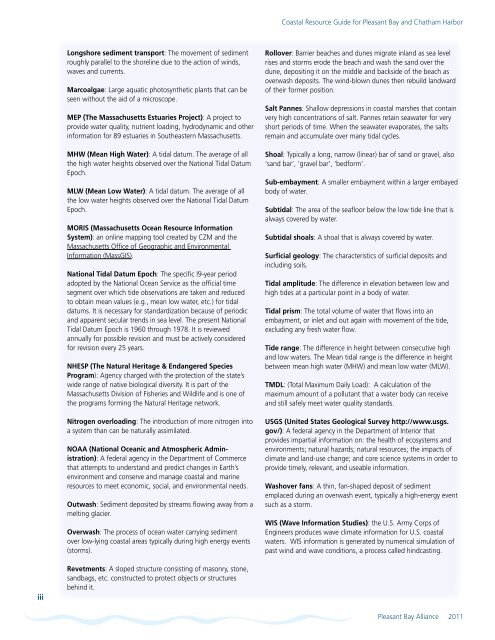Coastal Resource Guide Pleasant Bay and ... - Town to Chatham
Coastal Resource Guide Pleasant Bay and ... - Town to Chatham
Coastal Resource Guide Pleasant Bay and ... - Town to Chatham
You also want an ePaper? Increase the reach of your titles
YUMPU automatically turns print PDFs into web optimized ePapers that Google loves.
<strong>Coastal</strong> <strong>Resource</strong> <strong>Guide</strong> for <strong>Pleasant</strong> <strong>Bay</strong> <strong>and</strong> <strong>Chatham</strong> HarborLongshore sediment transport: The movement of sedimentroughly parallel <strong>to</strong> the shoreline due <strong>to</strong> the action of winds,waves <strong>and</strong> currents.Marcoalgae: Large aquatic pho<strong>to</strong>synthetic plants that can beseen without the aid of a microscope.MEP (The Massachusetts Estuaries Project): A project <strong>to</strong>provide water quality, nutrient loading, hydrodynamic <strong>and</strong> otherinformation for 89 estuaries in Southeastern Massachusetts.MHW (Mean High Water): A tidal datum. The average of allthe high water heights observed over the National Tidal DatumEpoch.MLW (Mean Low Water): A tidal datum. The average of allthe low water heights observed over the National Tidal DatumEpoch.MORIS (Massachusetts Ocean <strong>Resource</strong> InformationSystem): an online mapping <strong>to</strong>ol created by CZM <strong>and</strong> theMassachusetts Office of Geographic <strong>and</strong> EnvironmentalInformation (MassGIS).National Tidal Datum Epoch: The specific l9-year periodadopted by the National Ocean Service as the official timesegment over which tide observations are taken <strong>and</strong> reduced<strong>to</strong> obtain mean values (e.g., mean low water, etc.) for tidaldatums. It is necessary for st<strong>and</strong>ardization because of periodic<strong>and</strong> apparent secular trends in sea level. The present NationalTidal Datum Epoch is 1960 through 1978. It is reviewedannually for possible revision <strong>and</strong> must be actively consideredfor revision every 25 years.NHESP (The Natural Heritage & Endangered SpeciesProgram): Agency charged with the protection of the state’swide range of native biological diversity. It is part of theMassachusetts Division of Fisheries <strong>and</strong> Wildlife <strong>and</strong> is one ofthe programs forming the Natural Heritage network.Nitrogen overloading: The introduction of more nitrogen in<strong>to</strong>a system than can be naturally assimilated.NOAA (National Oceanic <strong>and</strong> Atmospheric Administration):A federal agency in the Department of Commercethat attempts <strong>to</strong> underst<strong>and</strong> <strong>and</strong> predict changes in Earth’senvironment <strong>and</strong> conserve <strong>and</strong> manage coastal <strong>and</strong> marineresources <strong>to</strong> meet economic, social, <strong>and</strong> environmental needs.Outwash: Sediment deposited by streams flowing away from amelting glacier.Overwash: The process of ocean water carrying sedimen<strong>to</strong>ver low-lying coastal areas typically during high energy events(s<strong>to</strong>rms).Rollover: Barrier beaches <strong>and</strong> dunes migrate inl<strong>and</strong> as sea levelrises <strong>and</strong> s<strong>to</strong>rms erode the beach <strong>and</strong> wash the s<strong>and</strong> over thedune, depositing it on the middle <strong>and</strong> backside of the beach asoverwash deposits. The wind-blown dunes then rebuild l<strong>and</strong>wardof their former position.Salt Pannes: Shallow depressions in coastal marshes that containvery high concentrations of salt. Pannes retain seawater for veryshort periods of time. When the seawater evaporates, the saltsremain <strong>and</strong> accumulate over many tidal cycles.Shoal: Typically a long, narrow (linear) bar of s<strong>and</strong> or gravel, also‘s<strong>and</strong> bar’, ‘gravel bar’, ‘bedform’.Sub-embayment: A smaller embayment within a larger embayedbody of water.Subtidal: The area of the seafloor below the low tide line that isalways covered by water.Subtidal shoals: A shoal that is always covered by water.Surficial geology: The characteristics of surficial deposits <strong>and</strong>including soils.Tidal amplitude: The difference in elevation between low <strong>and</strong>high tides at a particular point in a body of water.Tidal prism: The <strong>to</strong>tal volume of water that flows in<strong>to</strong> anembayment, or inlet <strong>and</strong> out again with movement of the tide,excluding any fresh water flow.Tide range: The difference in height between consecutive high<strong>and</strong> low waters. The Mean tidal range is the difference in heightbetween mean high water (MHW) <strong>and</strong> mean low water (MLW).TMDL: (Total Maximum Daily Load): A calculation of themaximum amount of a pollutant that a water body can receive<strong>and</strong> still safely meet water quality st<strong>and</strong>ards.USGS (United States Geological Survey http://www.usgs.gov/): A federal agency in the Department of Interior thatprovides impartial information on: the health of ecosystems <strong>and</strong>environments; natural hazards; natural resources; the impacts ofclimate <strong>and</strong> l<strong>and</strong>-use change; <strong>and</strong> core science systems in order <strong>to</strong>provide timely, relevant, <strong>and</strong> useable information.Washover fans: A thin, fan-shaped deposit of sedimentemplaced during an overwash event, typically a high-energy eventsuch as a s<strong>to</strong>rm.WIS (Wave Information Studies): the U.S. Army Corps ofEngineers produces wave climate information for U.S. coastalwaters. WIS information is generated by numerical simulation ofpast wind <strong>and</strong> wave conditions, a process called hindcasting.iiiRevetments: A sloped structure consisting of masonry, s<strong>to</strong>ne,s<strong>and</strong>bags, etc. constructed <strong>to</strong> protect objects or structuresbehind it.<strong>Pleasant</strong> <strong>Bay</strong> Alliance 2011
















